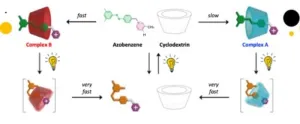(Press-News.org) The hormone estrogen regulates binge drinking in females, causing them to “pregame” – consume large quantities of alcohol in the first 30 minutes after it’s offered, according to a preclinical study led by scientists at Weill Cornell Medicine. The study establishes–for what is thought to be the first time–that circulating estrogen increases binge alcohol consumption in females and contributes to known sex differences in this behavior.
The findings, published Dec. 30 in the journal Nature Communications, could lead to novel approaches for treating alcohol use disorder.
“We know a lot less about what drives alcohol drinking behavior in females because most studies of alcohol use have been done in males,” said senior author Dr. Kristen Pleil, an associate professor of pharmacology. Yet females, too, overindulge and are more susceptible to the negative health effects of alcohol than males.
Recent studies indicate that, during the pandemic lockdown, women increased their heavy alcohol consumption more than men. That behavior has important consequences for women’s health, said Dr. Pleil, “because many studies show this pattern of drinking enhances alcohol’s harmful effects.” Indeed, women had many more alcohol-related hospital visits and complications than men during and since the pandemic.
Peak Levels of Estrogen Associated with Increased Alcohol Consumption
In a 2021 study, Dr. Pleil and her team showed that a specific subpopulation of neurons in a brain region called the bed nucleus of the stria terminalis (BNST) were more excitable in female mice than in males. This enhanced activity correlated with their binge drinking behavior.
But what makes this neural circuit more excitable in females? “Estrogen has such powerful effects on so many behaviors, particularly in females,” Dr. Pleil said. “So, it makes sense that it would also modulate drinking.”
To assess estrogen’s potential involvement, the researchers, including first author Dr. Lia Zallar, who was a graduate student in the Pleil lab at the time of the research, began by monitoring the hormone levels throughout estrous cycle of female mice. Then, they served up the alcohol. They found that when a female has a high level of circulating estrogen, she drinks much more than on days when her estrogen is low.
That enhanced bingeing behavior was reflected in heightened activity in those same neurons in the BNST. “When a female takes her first sip from the bottle containing alcohol, those neurons go crazy,” Dr. Pleil said. “And if she’s in a high-estrogen state, they go even crazier.” That extra boost of neural activity means the mice hit the bottle even harder, particularly within the first 30 minutes after the alcohol was made available, a behavior Dr. Pleil refers to as “front-loading.”
Surprising Discovery: Cell-surface Receptors Allow Estrogen to Act Fast
Although the researchers suspected estrogen would have an effect on drinking, they were surprised by its mechanism of action. This steroid hormone typically regulates behaviors by binding to receptors that then travel to the nucleus, where they alter the activity of specific genes—a process that could take hours. However, Dr. Pleil and her team realized that something else must be happening when estrogen infused directly into the BNST excited the neurons and triggered binge drinking within minutes.
So, the researchers tested estrogen that had been doctored so it could not enter cells and bind to nuclear receptors—a feat of chemical engineering performed by Dr. Jacob Geri, assistant professor of pharmacology at Weill Cornell Medicine. They determined that when estrogen promotes bingeing, the hormone is binding to receptors on the neurons’ surface, where it directly modulates cell-cell communication.
“We believe this is the first time that anybody has shown that during a normal estrous cycle, endogenous estrogen made by the ovaries can use such a rapid mechanism to control behavior,” Dr. Pleil said. That rapid action drives the front-loading of alcohol when estrogen is high.
The team identified the estrogen receptor that mediates this effect and determined that it is expressed in the excited BNST neurons and in neurons from other brain regions that excite them. The researchers are now investigating the signaling mechanisms for this effect, and they will also examine whether the same system regulates drinking in males.
“All of the infrastructure is there in males, too: the estrogen receptors and the basic circuit organization,” Dr. Pleil said. The only difference will be the source of the estrogen, which in males without an ovarian source relies on local conversion of testosterone to estrogen in the brain.
Inhibiting the enzyme that synthesizes estrogens could offer a novel treatment for selectively reducing alcohol consumption when hormone levels surge. An FDA-approved version of such an inhibitor is currently used to treat women with estrogen-sensitive cancers.
“Combining this drug with compounds that modulate the downstream effects of the chemicals produced by the BNST neurons could potentially provide a new, targeted approach for treating alcohol use disorder,” Dr. Pleil said.
END
Preclinical study finds surges in estrogen promote binge drinking in females
2024-12-30
ELSE PRESS RELEASES FROM THIS DATE:
Coming AI economy will sell your decisions before you take them, researchers warn
2024-12-30
The near future could see AI assistants that forecast and influence our decision-making at an early stage, and sell these developing “intentions” in real-time to companies that can meet the need – before we even realise we have made up our minds.
This is according to AI ethicists from the University of Cambridge, who say we are at the dawn of a “lucrative yet troubling new marketplace for digital signals of intent”, from buying movie tickets to voting for candidates. They call this the "Intention Economy".
Researchers from Cambridge’s Leverhulme Centre for the Future of Intelligence ...
NASA’s Parker Solar Probe makes history with closest pass to Sun
2024-12-27
Operations teams have confirmed NASA’s mission to “touch” the Sun survived its record-breaking closest approach to the solar surface on Dec. 24, 2024.
Breaking its previous record by flying just 3.8 million miles above the surface of the Sun, NASA’s Parker Solar Probe hurtled through the solar atmosphere at a blazing 430,000 miles per hour — faster than any human-made object has ever moved. A beacon tone received late on Dec. 26 confirmed the spacecraft had made it through the encounter safely and is operating normally.
This pass, the ...
Are we ready for the ethical challenges of AI and robots?
2024-12-27
Fukuoka, Japan―Artificial intelligence (AI) and AI-enabled robots are becoming a bigger part of our daily lives. Real-time, flexible interactions between humans and robots are no longer just science fiction. As robots become smarter and more human-like in both behavior and appearance, they are transforming from mere tools to potential partners and social entities.
This rapid evolution presents significant challenges to our legal and ethical frameworks, including concerns about privacy, safety, and regulation in the context of AI and robots. The Cambridge Handbook of the Law, Policy, ...
Nanotechnology: Light enables an "impossibile" molecular fit
2024-12-27
Exploiting an ingenious combination of photochemical (i.e., light-induced) reactions and self-assembly processes, a team led by Prof. Alberto Credi of the University of Bologna has succeeded in inserting a filiform molecule into the cavity of a ring-shaped molecule, according to a high-energy geometry that is not possible at thermodynamic equilibrium. In other words, light makes it possible to create a molecular “fit” that would otherwise be inaccessible.
“We have shown that by administering ...
Estimated vaccine effectiveness for pediatric patients with severe influenza
2024-12-27
About The Study: The findings from this case-control study suggest that children should receive influenza vaccination to protect against all levels of severe influenza illness.
Corresponding Authors: To contact the corresponding authors, email Kelsey M. Sumner, PhD, MSPH (rhq3@cdc.gov) and Samantha M. Olson, MPH (ylz8@cdc.gov).
To access the embargoed study: Visit our For The Media website at this link https://media.jamanetwork.com/
(doi:10.1001/jamanetworkopen.2024.52512)
Editor’s Note: Please see the article for additional information, including other authors, author contributions and affiliations, conflict of interest and financial disclosures, ...
Changes to the US preventive services task force screening guidelines and incidence of breast cancer
2024-12-27
About The Study: In this cohort study, in situ breast cancer decreased since 2009, consistent with decreasing use of screening mammography since the 2009 U.S. Preventive Services Task Force guideline changes, but this decrease did not appear to have translated to more advanced breast cancer stages at diagnosis or decreases in the proportion of cases treated with partial mastectomy. Further research is needed to understand the long-standing increase in localized invasive breast cancer and the decrease in regional invasive breast cancer observed during the past 20 years in the context of decreased breast ...
Urgent action needed to protect the Parma wallaby
2024-12-27
The creation of more fox-free safe havens and greater collaboration between government and landowners is needed to ensure the survival of a species of wallaby, an expert from The Australian National University (ANU) argues.
The Parma wallaby, also known as the white-throated wallaby, is listed as a vulnerable species in Australia, while the International Union for Conservation of Nature (IUCN) classifies it as Near Threatened. The marsupial is found along the Great Dividing Range in northern New South Wales.
According to ANU Professor George Wilson, who is a co-author of a new ...
Societal inequality linked to reduced brain health in aging and dementia
2024-12-27
Researchers from Trinity College Dublin have collaborated with international partners to explore if societal inequality affects our brain. Their research paper is published in Nature Aging today, [Friday, December 27th] by an international team of researchers from the Multipartner Consortium to expand dementia research in Latin America (ReDLat), the Latin American Brain Health Institute (BrainLat), the GIobal Brain Health Institute (GBHI) at Trinity College Dublin, and other centres across the globe. The study reveals a direct link between structural inequality—such as socioeconomic disparities measured by a country-level index ...
Singles differ in personality traits and life satisfaction compared to partnered people
2024-12-26
Although being married or in a long-term relationship is often seen as the norm, more people are staying single for life. But singlehood can bring economic and medical disadvantages, especially as people get older and may become more reliant on others.
New research in Psychological Science reveals that lifelong singles have lower scores on life satisfaction measures and different personality traits compared to partnered people, findings that point to the need for both helpful networks and ways to create such networks that are better catered to single people.
“When there are ...
President Biden signs bipartisan HEARTS Act into law
2024-12-26
WASHINGTON, D.C., December 26, 2024 — President Biden earlier this week signed into law the bipartisan Cardiomyopathy Health Education, Awareness, Research and Training in Schools (HEARTS) Act, which will help ensure students and staff in schools nationwide are prepared to respond to a cardiac emergency. The bipartisan legislation unanimously passed the U.S. House of Representatives in September and the U.S. Senate earlier this month.
The American Heart Association, which is celebrating 100 years of lifesaving service as the world’s leading voluntary organization focused on heart and brain health, strongly supports this legislation as part of its goal to double the survival ...



